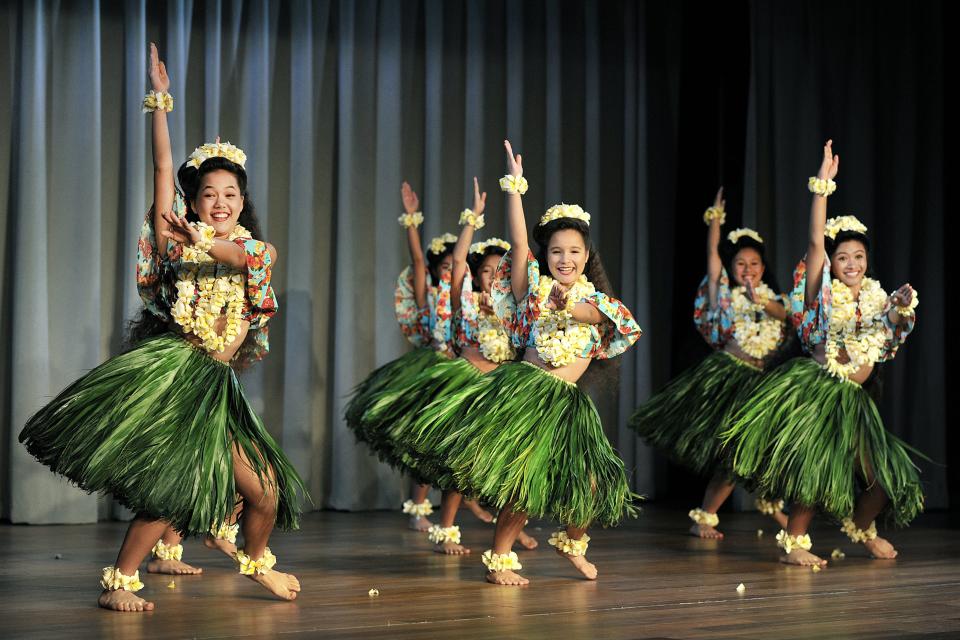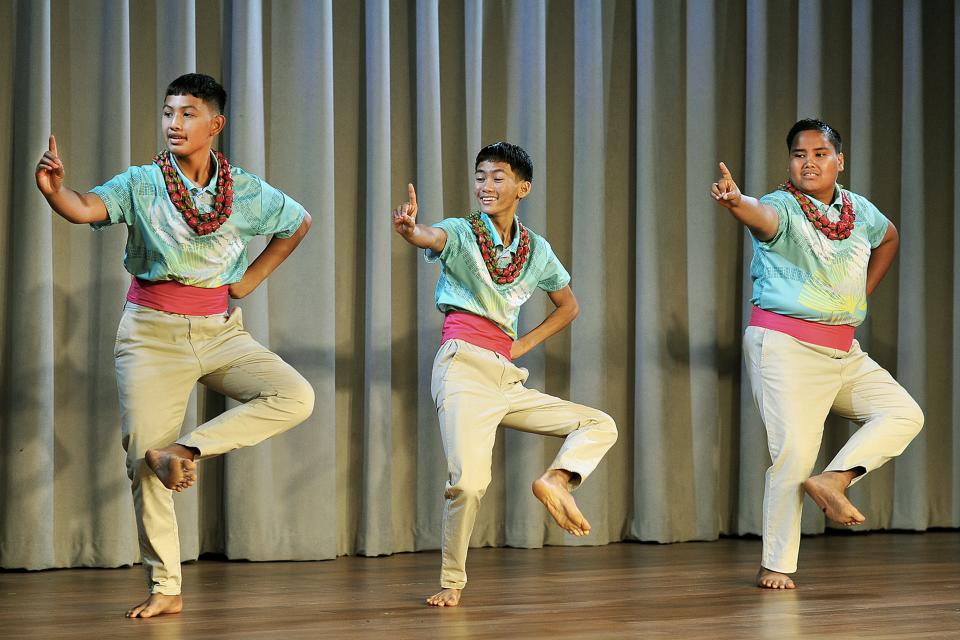Hula was once banned in Hawaii, this competition fosters the next generation of dancers
MAUI, Hawaii – Clipped into hair and strung into leis, fresh plumerias fill the banquet hall with a sweet scent. Soon, the dim stage lights brighten and the audience quiets. A group of 10 or so kaikamahine, or girls, take the stage outfitted in ruffled off-the-shoulder tops with vintage-inspired bloomers that peek out from their paʻu, or skirt made of green palm leaves. The hula dancers get into position.
The band behind the audience starts to play Duke Ellington's 1938 song "Swingtime in Honolulu" and the dancers are all smiles. Synchronized almost flawlessly, they give an energetic performance evoking old Hawaii.

The crowd erupts loudly – not just into claps and cheers, but deafening "chee-hoos," a shout of excitement in Hawaii with roots in Polynesian war cries. The audience comprises others from the dancers' hālau, or hula school, and their ʻohana, or family. The energy is palpable.
This hula experience is unlike what you’d see attending a luau.
It is the second day of performances for Hula O Nā Keiki, the only Maui-based hula competition for children ages 5 through 17. For the past 30 years, children from across the state have gathered at Kāʻanapali Beach Hotel to learn, interpret and perform mele, or songs, about Maui. This year, seven hālau, led by their kumu, or teacher, from across the state competed.
Gracing the stage this year were solo dancers competing to be Miss and Master Hula O Nā Keiki, and for the first time, group performances, like the one who performed to "Swingtime in Honolulu."
Not only does the event push haumana, or students, to put on their best hula performance, but also to reflect on their relationship with hula and their identity as Hawaiian. Ultimately, it’s an opportunity to perpetuate Hawaiian culture and prove that the visually captivating art of hula is alive and evolving.
Wayfinding in Hawaii: Meet Kala Baybayan Tanaka, a Hawaiian navigator who helped shape Disney's 'Moana'
The past, present and future of hula
During the three-day event, Hula O Nā Keiki competitors performed the two overarching styles of hula. On Friday, they performed kahiko, a more traditional hula featuring oli (chant) and percussion instruments – like a drum made with sharkskin and the trunk of a coconut tree. On Saturday, they danced ʻauana – the contemporary hula that most people are familiar with, featuring hapa haole songs (music in English and Hawaiian).
A sacred storytelling practice that originated long before Europeans touched down on the islands, hula is a pillar in Hawaiian culture and the way to document stories and events. Accompanied by oli and mele, dancers use their bodies and movement to tell stories, ranging from the history of the islands to legends of gods and goddesses. Some hula is only performed at certain times, like the birth of a child or an earthquake.
Hula wasn't always celebrated as it is today. In the 1800s, Western missionaries sought to wipe out Hawaiian culture by banning the Hawaiian language from being taught in schools and hula. Public performances of hula were banned, and the dance was taught secretly for the following decades. If caught performing hula, a person could be charged a hefty fine. When King David Kalākaua took the throne in the late 1800s, he made it his mission to revitalize hula and other Hawaiian practices.

In the early 20th century, hula dancers were sexualized and packaged for tourism and Hollywood. Then in the 1970s, Native Hawaiians brought about the Hawaiian Renaissance, a movement focusing on resurging Hawaiian culture, including the art of hula.
"At the very beginning of this competition 30 years ago, the kumu hula fluent in Hawaiian, fluent in composition, was rare," Hokulani Holt-Padilla, head judge of Hula O Nā Keiki and a kumu herself, told USA TODAY. "As (time has passed and) Hawaiian culture has become stronger, kumu hula are able to do that themselves. They don't have to rely on someone’s translation of a mele."
One 16-year-old contestant even wrote her own mele this year. "That was not done before," Holt-Padilla said. "As our Hawaiian community has strengthened and evolved, our competition tries to foster that as well."
The winning kumu, Robert Keʻano Kaʻupu IV and Lono Padilla from Hālau Hi'iakaināmakalehua on Oahu said they see "every new keiki that comes into our hālau as a potential kumu hula, a potential someone to take what we have taught them and carry it forward."
"That's a potential person to carry on our lineage," Kaʻupu IV said.

The invitation to Hula O Nā Keiki was exciting for Kaʻupu IV and Padilla. “We jumped at the opportunity,” Kaʻupu IV said. Due to the pandemic, hula events had been canceled for almost three years, so it was a chance for their youngest students to get time onstage. For some, it was their first performance ever.
When choosing the mele for the soloists, the kumu chose ones related to aliʻi (royalty) from Maui, stories the dancers could connect to. Dancer Lennon Aiko Kuʻualoha Nakada, 13, honored Keopuolani, a chiefess of Maui. Dancer Noah Kazuo Piʻimaiwaʻa Andrade, 10, honored King Kahekili Nui ʻAhumanu, Maui’s high chief and warrior. These two went on to win the Miss and Master Hula O Nā Keiki titles.
Experience Kauai: 8 free or cheap things to do in Kauai, Hawaii, that are enriching in other ways
Overtourism in Hawaii: To manage overcrowding, are reservation systems the future of tourism in Hawaii?
Putting in the work
Starting in June, the soloists practiced their choreography five days a week during the summer and then four days when the school year commenced – all while staying on top of school work and other obligations.
It wasn’t just the students who worked hard for the competition. Parents strung the lei and sewed the costumes, with help from the keiki, of course. One Saturday morning, the keiki went to the teacher’s home to dye and rub dirt into fabric to get a rusty tint. The kids also created their own ohe kapala, used to stamp fabric that would be made into their kahiko outfit.
Seeing all the visions come to life that weekend brought tears to the eyes of Kaʻupu IV and Padilla.
"We were just proud of everything that they did, beyond just us," Padilla said. "We were proud of all of the kids that performed this weekend and all of the other kumu and family who put in the same work we did."
Besides preparing for their dance performance, the students also had to get ready for a private interview with the judges – no family or kumu allowed. In the interview, the students are prompted to talk about their journey and relationship with hula.
"There are very few competitions that require an interview, so that was kind of a game changer," Kaʻupu IV said. It made the students reflect on their Hawaiian identity and what they have learned, he added. "(The interview) pushes boundaries for a dancer being more than just physical, more than just aesthetic."
At these competitions, the setting is different from other kinds of performances. "We’re former luau show dancers," he said. "It took us a week to learn everything and jump on the stage. But for competition, we practice a song or two for months and months."
"If someone is going to Hawaii and there's a hula competition, go," Kaʻupu IV said. "That’s where the authentic hula is – the best adjudicators, the best musicians, the best hālau. If you want to experience the authentic stuff, go where the authentic stuff is."
This article originally appeared on USA TODAY: The Hula O Na Keiki competition fosters the next generation of dancers

 Yahoo Movies
Yahoo Movies 
